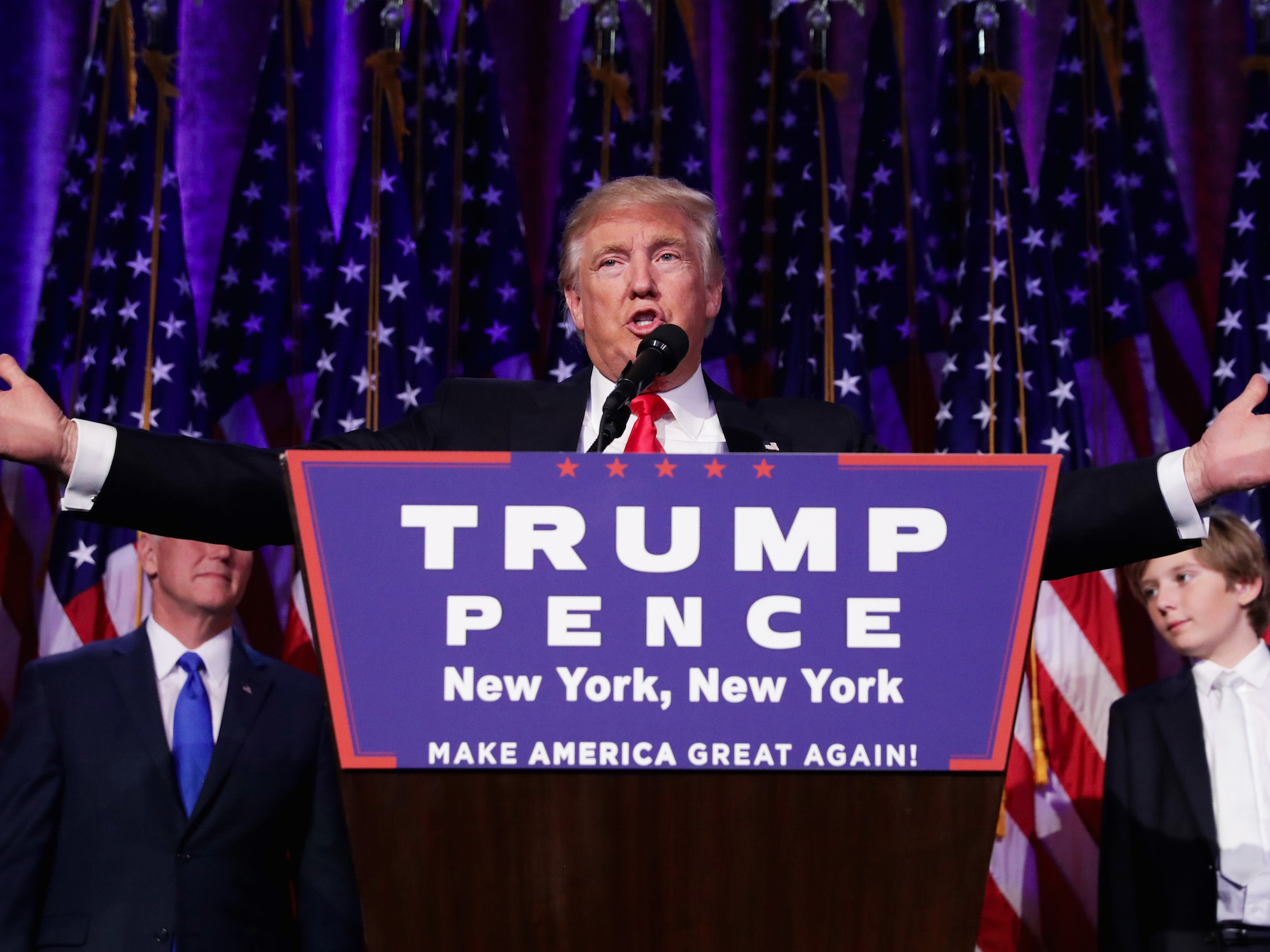Wall Street analysts are trying to figure out just what the economy will look like under a President Donald Trump.
And though many questions are still unanswered, they are nearly unanimous on one thing: Trump’s policies will most likely bring about a significant uptick in inflation.
In other words, the prices of everything in America may be about to increase because of heavy spending by the government on infrastructure, for example, and restrictions on trade and immigration.
It was one of the dominant trades on Wall Street after Trump’s surprise victory.
Specifically, there was a “broad-based rise in inflation swaps” on Wednesday, according to Bruce Kasman, head of economic research at JPMorgan. A salesman put it more simply when asked what he was seeing early Wednesday: a “massive bid for inflation.”
"Donald Trump's platform has an inflationary bias: His fiscal policy is likely to be expansionary, and he leans toward protectionism, which is inflationary due to the effects of tariffs and curtailed immigration," Mark Haefele, the chief investment officer at UBS, wrote in a note to clients.
Let's break that down in to its two constituent parts: increased government spending and trade barriers.
Fiscal stimulus
In the lead-up to the election, Trump's campaign laid out a plan for $1 trillion in public and private investment in infrastructure that would generate revenue through things such as toll roads and airports.
According to analysts, the combination of a tight labor market and increased money supply in the economy would put pressure on prices. The US is already operating at near full employment, and Trump's commitment to tighten the borders and deport immigrants could potentially reduce the labor force further.
"US fiscal stimulus (which is not currently built into our US or global outlook) would boost global demand," Kasman wrote. "With most of the benefits of this stimulus accruing to a US economy operating close to full employment, it would likely increase US and global inflation."
Essentially, with wage pressures already rising in the economy - higher wages are thought to lead to businesses increasing prices - increased hiring for these projects would lead to broader price increases.
Increase of trade barriers
One of the key focuses in Trump's speech outlining his first 100 days was changing the way America trades with the rest of the world by "renegotiating" deals such as the North American Free Trade Agreement and pulling out of the Trans-Pacific Partnership.
Analysts believe that these changes would most likely be protectionist and lead to inflation. Increasing trade barriers could include tariffs - taxes for importing or exporting goods - making it more expensive to import parts for goods.
"Restrictive trade policies slow activity and boost inflation in early 2017 as a marked shift in public policy alters the landscape in a way that reduces the intensity of tradable activity while encouraging domestic production and consumption," said Michael Gapen, chief US economist at Barclays.

As noted by the anonymous finance blogger Macro Man, the personal consumption expenditures price index for durable goods (anything that lasts more than two years, like cars or computers) peaked right before the passage of NAFTA and has been declining ever since. Thus a more protectionist trade agreement could lead to higher prices for those types of items.
"Altering trade deals to get a 'better deal' for America is likely to increase inflation via reduced supply," wrote Kevin Gaynor and Sam Bonney, strategists at Nomura. "Reducing the labor force is aimed at increasing wages. Onshoring is aimed at increasing jobs and, presumably, real wages along with corporate costs."
As with many of Trump's campaign promises, however, it's unclear the extent to which they would be carried out.
"One thesis is immediate tariffs are a negative supply-side shock, lifting inflation and undermining growth," said Alan Ruskin at Deutsche Bank. "The open question is how far Trump embarks down this path, or whether he opens the door to pragmatic renegotiation of trade agreements that again has some parallels with the UK, albeit the US will be negotiating from a position of strength."
Impact on the Fed
The increased inflation pressures will have a widespread effect on consumers, businesses, and the Federal Reserve.
For the Fed, it appears that the long-awaited inflation may lead it to increase its rate of interest rate hikes.
"I would expect there to be more fiscal spending in the future that will accelerate any potential inflation in the system," Jerry Haworth, CEO of the London-based hedge fund 36 South Capital Advisors, told Business Insider's Ben Moshinsky. "The quicker inflation returns, the quicker interest rates may go up."

The increase of interest rate hikes, however, could work one of two ways.
On the one hand, inflation has been running well below the Fed's desired 2% target for years, so some inflation could help to reach its policy goals. Stable inflationary increases would allow the Fed to raise interest rates to a level that is more in line with the long-term norm, giving it room to drop rates when the next recession comes.
On the other hand, inflation has naturally progressed at a rate closer to the 2% target, with core PCE slightly above 1.7% at its most recent reading, which is well above its 1.3% mark in December.
Thus highly inflationary policies coupled with already progressing inflation could lead to a surge in price increases. This would put the Fed behind the curve - and, in the worst case, force it into a furious series of rate hikes from its current historically low rate, in turn dampening economic activity.
Impact on businesses
As with the Fed, there are two ways this could play out for the largest businesses in America.
In the positive scenario, increased pricing power allows companies to pass along higher wages and input prices to consumers, maintaining margins and continuing strength in the corporate sector.
In the negative scenario, the increased tariffs make life more expensive for companies and wages do not keep track with the rising costs, crushing margins. Additionally, those companies that do business outside of the country - roughly 33% of revenues for the S&P 500 come from overseas - could take a hit if the Fed raises rates, as a stronger dollar would hurt the value of revenue generated overseas.
Impact on consumers
As companies look to American workers to replace immigrants, and new fiscal stimulus jobs require more workers in an already tight labor market, wage pressures would likely increase.
On the other hand, Trump's trade plans would also make purchasing goods more expensive, especially those shipped from overseas. Things like iPhones, cars, and even foods that are sourced from outside the US would become more expensive with higher tariffs.
It's not all certain
A few caveats here.
For one, it is unknown how many of these promises Trump will actually keep. Even in his deficit hawks within his own party may not agree with the idea of large-scale fiscal stimulus.
During President Barack Obama's term, many Republicans were against a stimulus package that was smaller than Trump's proposed one and that came in the depths of a recession, when stimulus is thought to be most effective.
Additionally, Trump has laid out broad policy proposals but not finer details - especially on trade - so the exact nature of the president-elect's plan is unclear.
As with many things over the coming months, we'll just have to wait and see.

